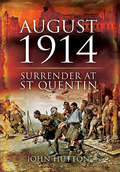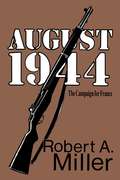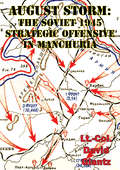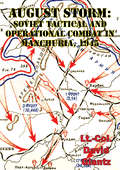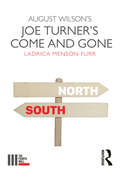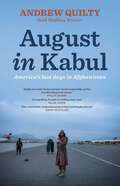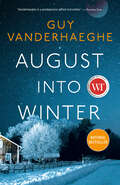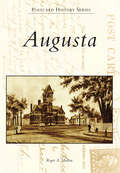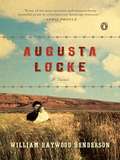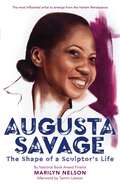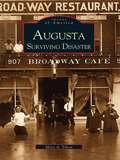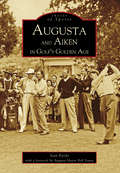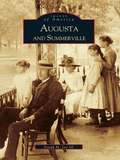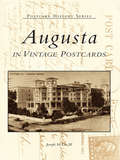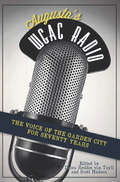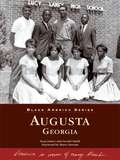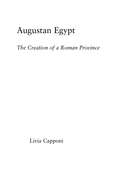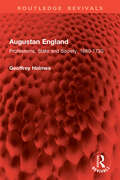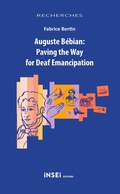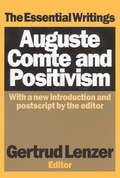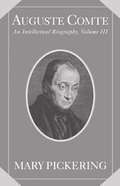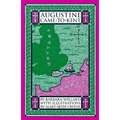- Table View
- List View
August 1914: Surrender at St Quentin
by John HuttonThe great retreat of the British Expeditionary Force from Mons in August 1914 is one of the most famous in military history, and it is justly celebrated. But not all the British soldiers who were forced back by the German offensive performed well. Two colonels, Elkington and Mainwaring, tried to surrender rather than fight on, and were disgraced. This is their story. In this compelling account John Hutton shows, in graphic detail, the full confusion of the retreat, and the dire mental state to which brave men can be reduced by extreme stress, uncertainty and fatigue. But he also describes how Elkington redeemed himself. He joined the French Foreign Legion, fought gallantly, was severely wounded and was reinstated by King George V. His is one of the more remarkable stories to come out of the Great War, as is the story of the attempted surrender at St. Quentin itself.
August 1944: The Campaign for France
by Robert A. MillerRobert A. Miller has written an exciting and well-documented account of a month that changed history. It is a true and accurate picture of the war as it was fought - day by day. In the tradition of Cornelius Ryan, this is popular military history at its best.
August Na (The Ninth of August)
by Manoranjan Das Arun Kumar Mohanty Jatindra Kumar NayakThe Ninth of August: An English translation by Arun Kumar Mohanty and Jatindra Kumar Nayak of Manoranjan Das's original Oriya play August Na. Sahitya Akademi, New Delhi (2005).
August Storm: Soviet Tactical And Operational Combat In Manchuria, 1945 [Illustrated Edition]
by Colonel David M Glantz[Includes 19 tables, 7 figures, 41 maps]To be successful, a strategic military operation requires careful planning and meticulous execution. History applauds the commander who orchestrates the operation, and major subordinate commanders share in the glory. In reality, however, commanders and soldiers at the operational and tactical levels play an even more critical role in achieving battlefield success. History often accords them little attention.Practitioners of war must study war at all levels. An understanding of the strategic aspects of military operations is essential in order to provide a context for a more detailed and equally critical understanding of precise operational and tactical techniques. Few officers practice war at the strategic level. The majority wrestle with the myriad of problems associated with implementing those strategic plans.Leavenworth Paper no. 8. through the medium of detailed case studies, examines the operational and tactical aspects of a major strategic operation--the Soviet offensive m Manchuria in 1945. The case studies, which involve army, corps, division, regimental, and battalion operations, focus on the many problems commanders and soldiers at that level face. Constrained by time, a desperate enemy, rugged terrain, and severe climatic conditions--the realities of war-- Soviet commanders devised find implemented techniques that produced victory. This paper highlights those techniques in the knowledge that Soviet theorists have likewise studied them in detail, both historically and in a contemporary context.
August Storm: The Soviet 1945 Strategic Offensive In Manchuria [Illustrated Edition]
by Colonel David M Glantz[Includes 15 tables, 1 tables, 26 maps]In August 1945, only three months after the rumble of gunfire had subsided in Europe, Soviet armies launched massive attacks on Japanese forces in Manchuria. In a lightning campaign that lasted but ten days, Soviet forces ruptured Japanese defenses on a 4,000-kilometer front, paralyzed Japanese command and control, and plunged through 450 kilometers of forbidding terrain into the heartland of Manchuria. Effective Soviet cover and deception masked the scale of offensive preparations and produced strategic surprise. Imaginative tailoring of units to terrain, flexible combat formations, and bold maneuvers by armor-heavy, task-organized forward detachments and mobile groups produced operational and tactical surprise and, ultimately, rapid and total Soviet victory.For the Soviet Army, the Manchurian offensive was a true postgraduate combat exercise. The Soviets had to display all the operational and tactical techniques they had learned in four years of bitter fighting in the west. Though the offensive culminated an education, it also emerged as a clear case study of how a nation successfully begins a war in a race against the clock arid not only against an enemy, but also against hindering terrain.Soviet military historians and theorists have recently focused on the Manchurian offensive, a theater case study characterized by deep mobile operations on a broad front designed to pre-empt and overcome defenses. Because these characteristics appear relevant to current theater operations, the Soviets study the more prominent operational and tactical techniques used in Manchuria in 1945. What is of obvious interest to the Soviet military professional should be of interest to the U.S. officer as well.
August Weismann
by Frederick B. ChurchillAugust Weismann's 1892 theory that inheritance is transmitted through eggs and sperm provided the biological mechanism for natural selection. In this full-length biography, Frederick Churchill situates Weismann in the swirling intellectual currents of his day and shows how his work paved the way for the modern synthesis of genetics and evolution.
August Wilson's Joe Turner's Come and Gone (The Fourth Wall)
by Ladrica Menson-Furr"Herald Loomis, you shining! You shining like new money!" - Bynum Walker August Wilson considered Joe Turner’s Come and Gone (1984) to be his favourite play of the ten in his award-winning Pittsburgh Cycle. It is a drama that truly examines the roots, crossroads, and intersections of African, American, and African American culture. Its characters and choral griots interweave the intricate tropes of migration from the south to the north, the effects of slavery, black feminism and masculinity, and Wilson's theme of finding one's "song" or identity. This book gives readers an overview of the work from its inception on through its revisions and stagings in regional theatres and on Broadway, exploring its use of African American vernacular genres—blues music, folk songs, folk tales, and dance—and nineteenth-century southern post-Reconstruction history. Ladrica Menson-Furr presents Joe Turner's Come and Gone as a historical drama, a blues drama, an American drama, a Great Migration drama, and the finest example of Wilson's gift for relocating the African American experience in urban southern cities at the beginning and not the end of the African American experience.
August in Kabul: America's last days in Afghanistan
by Andrew QuiltyAs night fell on 15 August 2021, the Taliban entered Kabul, capital of Afghanistan. After a 20-year conflict with the United States, its Western allies and a proxy Afghan government, the Islamic militant group once aligned with al Qaeda was about to bury yet another foreign foe in the graveyard of empires. And for America, the superpower, this was yet another foreign disaster. As cities and towns fell to the Taliban in rapid succession, Western troops and embassy staff scrambled to flee a country of which they had lost control. To the world, Kabul in August looked like Saigon in 1975. August in Kabul is the story of how America's longest mission came to an abrupt and humiliating end, told through the eyes of Afghans whose lives have been turned upside down: a young woman who harbours dreams of a university education; a presidential staffer who works desperately to hold things together as the government collapses around him; a prisoner in the notorious Bagram Prison who suddenly finds himself free when prison guards abandon their post. Andrew Quilty was one of a handful of Western journalists who stayed in Kabul as the city fell. This is his first-hand account of those dramatic final days.
August into Winter: A Novel
by Guy VanderhaegheThe first novel in nearly a decade from the three-time Governor General's Award‒winning author of The Last Crossing, August Into Winter is an epic story of crime and retribution, of war and its long shadow, and of the redemptive possibilities of love.You carried the past into the future on your back, its knees and arms hugging you tighter with every step.It is 1939, with the world on the brink of global war, when Constable Hotchkiss confronts the spoiled, narcissistic man-child Ernie Sickert about a rash of disturbing pranks in their small prairie town. Outraged and cornered, Ernie commits an act of unspeakable violence, setting in motion a course of events that will change forever the lives of all in his wake.With Loretta Pipe—the scrappy twelve-year-old he idealizes as the love of his life—in tow, Ernie flees town. In close pursuit is Corporal Cooper, who enlists the aid of two brothers, veterans of World War One: Jack, a sensitive, spiritual man with a potential for brutal violence; and angry, impetuous Dill, still recovering from the premature death of his wife who, while on her deathbed, developed an inexplicable obsession with the then-teenaged Ernie Sickert.When a powerful storm floods the prairie roads, wreaking havoc, Ernie and Loretta take shelter in a one-room schoolhouse where they are discovered by the newly arrived teacher, Vidalia Taggart. Vidalia has her own haunted past, one that has driven her to this stark and isolated place with only the journals of her lover Dov, recently killed in the Spanish Civil War, for company. Dill, arriving at the schoolhouse on Ernie's trail, falls hard and fast for Vidalia—but questions whether he can compete with the impossible ideal of a dead man.Guy Vanderhaeghe, writing at the height of his celebrated powers, has crafted a tale of unrelenting suspense against a backdrop of great moral searching and depth. His is a canvas of lavish, indelible detail: of character, of landscape, of history—in all their searing beauty but all their ugliness, too. Vanderhaeghe does not shrink from the corruption, cruelty, and treachery that pervade the world. Yet even in his clear-eyed depiction of evil—a depiction that frequently and delightfully turns darkly comic—he will not deny the possibility of love, of light. With August Into Winter, Guy Vanderhaeghe has given us a masterfully told, masterfully timed story for our own troubled hearts.
Augusta (Postcard History Series)
by Roger A. MadoreBuilt in 1754 on the eastern bank of the Kennebec River, Fort Western became one of the first permanent settlements in what would eventually become Augusta and, in 1827, the capital of Maine. Through innovations in publishing by Gannett & Morse and Vickery & Hill, textiles by the Edwards Manufacturing Company, and lumber production along the Kennebec, Augusta thrived and prospered. Water Street flourished into the business and cultural center of the city, while Green and Winthrop Streets became some of the area's most opulent residential neighborhoods. A trolley system and the Maine Central Railroad station tied Augusta to surrounding communities and allowed visitors to come from far and wide and spend many a night at the famed Augusta House.
Augusta Locke
by Henderson William HaywoodAn indelible portrait of a woman who through great toughness of character blazes her own trail Novelist William Haywod Henderson has won acclaim for his depictions of land and nature and his ability to bring the American West to vivid life. Of his most recent novel, The Rest of the Earth, Annie Proulx remarked that Henderson "writes some of the most evocative and transcendently beautiful prose in contemporary American literature. " Redolent with myth, humor, strange landscapes, and stark reality, Henderson's new novel tells the story of Augusta Locke, a troubled yet spirited woman, as she raises her daughter in the deserts of Wyoming. Spanning the twentieth century, Augusta's extraordinary challenges play out themes of love and loss, home and family, redemption and reconciliation. .
Augusta Locke
by William Haywood HendersonAn indelible portrait of a woman who through great toughness of character blazes her own trail Novelist William Haywod Henderson has won acclaim for his depictions of land and nature and his ability to bring the American West to vivid life. Of his most recent novel, The Rest of the Earth, Annie Proulx remarked that Henderson "writes some of the most evocative and transcendently beautiful prose in contemporary American literature." Redolent with myth, humor, strange landscapes, and stark reality, Henderson's new novel tells the story of Augusta Locke, a troubled yet spirited woman, as she raises her daughter in the deserts of Wyoming. Spanning the twentieth century, Augusta's extraordinary challenges play out themes of love and loss, home and family, redemption and reconciliation.
Augusta Savage: The Shape of a Sculptor's Life
by Marilyn NelsonA Claudia Lewis Award Winner for Poetry by the Bank Street College of Education A Black Caucus ALA Children & Young Adult Award Winner A CCBC Children&’s Choice • A CBC Teacher Favorite This powerful biography in poems tells the life of Augusta Savage, the trailblazing artist and pillar of the Harlem Renaissance. Augusta Savage was arguably the most influential American artist of the 1930s. A gifted sculptor, Savage was commissioned to create a portrait bust of W.E.B. Du Bois for the New York Public Library. She flourished during the Harlem Renaissance, and became a teacher to an entire generation of African American artists, including Jacob Lawrence, and would go on to be nationally recognized as one of the featured artists at the 1939 World&’s Fair. She was the first-ever recorded Black gallerist. After being denied an artists&’ fellowship abroad on the basis of race, Augusta Savage worked to advance equal rights in the arts. And yet popular history has forgotten her name. Deftly written and brimming with photographs of Savage&’s stunning sculpture, this is an important portrait of an exceptional artist who, despite the limitations she faced, was compelled to forge a life through art and creativity. Features an afterword by the curator of the Art & Artifacts Division of the Schomburg Center for Research in Black Culture. NAMED ONE OF THE BEST BOOKS OF THE YEAR BY Horn Book • Kirkus Reviews • School Library Journal • Bank Street College ★ "A stunning portrait of artistic genius and Black history in America." —Booklist, starred review ★ "A wonderful addition to young people&’s literature on African American artists." —Horn Book, starred review ★ "In a rich biography in verse, Nelson (A is for Oboe) gives voice to the Black sculptor Augusta Savage (1892-1962), a key Harlem Renaissance figure." —Publishers Weekly, starred review ★ "Nelson&’s arresting poetry, which is accompanied by photographs of Savage&’s work, dazzles as it experiments with form. … A lyrical biography from a master of the craft." —Kirkus Reviews, starred review ★ "A master poet breathes life and color into this portrait of a historically significant sculptor and her remarkable story." —School Library Journal, starred review
Augusta Surviving Disaster: Surviving Disaster (Images of America)
by Misty A. TilsonAugusta: Surviving Disaster allows readers to glimpse the changes that mother nature and human error have wrought on the landscape and design of the "Garden City." These disasters did not only alter the city's landscape; many were the impetus for change in Augusta. The ravaging floods led to the construction of the levee along the Savannah River in 1919, to prevent flooding, and spurred the creation of the Clark Hill Dam and Reservoir. Within this volume, readers will get a glimpse of the damagecaused by the floodwaters of the Savannah River and the Augusta Canal. The remains of St. Paul's Episcopal Church, as well as other homes and businesses, after the Great Fire of 1916 are captured. Historic photographs reveal the damaged remains of the Lower Market after the 1878 tornado. Culled from the extensive collection of the Augusta Museum of History and the personal collection ofJoseph M. Lee III, these images provide testimony to the resiliency of the human spirit and the courage to move forward and rebuild. The citizens of Augusta have a long history of uniting for the common good, and this volume is a tribute to those who overcameobstacles to create the thriving community that exists today.
Augusta and Aiken in Golf's Golden Age (Images of Sports)
by Stan Byrdy Augusta Mayor YoungThe game of golf got its start in the Southeastern United States in 1892 on four holes with sand greens at Palmetto Golf Club in Aiken, South Carolina. Within five years, Palmetto had expanded to eighteen holes and the first nine-hole course in neighboring Augusta, Georgia was designed at the Hotel Bon Air. For half a century, the Augusta-Aiken area flourished as the winter destination of choice for the rich, famous, and powerful in America. Presidents Taft, Harding, and Eisenhower vacationed here. Baseball great Ty Cobb bought a home in Augusta's quaint Summerville neighborhood. It was here that Bobby Jones began the improbable journey towards a Grand Slam, then built his dream golf course. By the turn of the century, winter tourism and grand resort hotels in the Augusta-Aiken area were well established. A favorable winter climate and easy rail access drew vacationers to Highland Park Hotel (1866), Willcox Hotel (1898), and Park in the Pines (1900) in Aiken; Hotel Bon Air (1890) and Partridge Inn (1913) in Augusta; and Hampton Terrace Hotel and Golf Club (1903) in North Augusta. Resorts in Florida and the growth of the air travel industry later coupled to mark the area's decline in winter tourism, but not before Augusta-Aiken's place in golf history was secure. In this unique volume, vintage images and accompanying text recall the unfo rgettable legends, the meticulously maintained courses, and all of the grandeur associated with the game.
Augusta and Summerville
by Joseph M. Lee IIIAugusta and Summerville showcases rare nineteenth-century stereoviews and photographs from the extensive collection of Joseph M. Lee III and the Augusta Museum of History, spanning a 41-year period from 1859 to 1900. The engaging images within these pages were captured on film by some of Augusta's earliest photographers, including J.W. Perkins, JohnUsher Jr., J.A. Palmer, and H.C. Hall, among others. Most of the images have never been published and provide an unusually valuable source of information about Augusta and its environs. Known the world round for its pristine landscapes and "Garden City" charm, Augusta has always been a photographer's dream. Lush, verdant scenes recall a city yet unmarked by the scars of expansion, still enjoying the tranquility of life in the Old South. Views of early businesses and homes on Broad and Greene Streets, the flood of 1888, local monuments, historic churches and cemeteries, pioneering schools, the early cotton crop, and area waterwaysall contribute to this visual journey. The reader will delight in scenes of yesteryear, diving deep into the annals of one of Georgia's most beloved cities.
Augusta in Vintage Postcards (Postcard History Series)
by Joseph M. Lee IIIIn the early 1900s, America was swept up in the postcard craze. All over the country, people seized on these charming snapshots of life as a means of keeping in touch with friends and family, as well as seeing strange and exciting parts of the world.
Augusta's WGAC Radio: The Voice of the Garden City for Seventy Years
by Debra Reddin van Tuyll Scott HudsonWGAC is the No. 1-rated radio station in Augusta. It has weathered the transition in American radio from local stations with local programming to corporately owned stations that feature syndicated programming, and it has been able to do so without giving up its local character. As a news-talk radio station today, WGAC is the first place most Augustans go to find out what is happening nationally and locally, and its morning drive-time and afternoon drive-time show hosts and news personnel are some of the most beloved and respected media figures in Augusta. This book will trace the history of this community landmark from its infancy to its status today as a community institution. It will highlight the people who have created the programming for which WGAC is known and also the people like James Brown who have used the station to launch important careers. The book will also discuss Fuqua's broadcasting technology innovations such as advances in acoustics engineering and early television technology. The history will also cover the station's decades-long support of the Master's Golf Tournament, which has led to it becoming the official radio station of the Master's.
Augusta, Georgia (Black America Series)
by Sean Joiner Marva Stewart Gerald SmithFilled with remarkable vintage photographs, Black America: Augusta, Georgia captures the essence of the African-American heritage in this historic Southern community. The Garden City has produced a wide variety of intellectual and political pioneers, including a handful of educators who were instrumental in the pivotal Brown versus Board of Education case. Within the pages of this volume, their stories unfold.
Augustan Egypt: The Creation of a Roman Province (Studies in Classics)
by Livia CapponiFirst published in 2005. Routledge is an imprint of Taylor & Francis, an informa company.
Augustan England: Professions, State and Society, 1680-1730 (Routledge Revivals)
by Geoffrey HolmesFirst published in 1982, Augustan England provides ample substance to reinforce the thesis that the years from 1680 to 1730 mark the most decisive stage in the rise of the English professional classes before the 19th century, and that this had profound consequences in maintaining the relative ‘openness’ of 18th century society until the advent of industrialization.This book provides the first ever authoritative study of the professions, as a whole, before the Victorian age. The spectacular growth and prosperity of the professional sector of English society at a time when population growth was minimal is seen by Professor Holmes as a mirror of the transformation of England herself in these same years. The Augustan age was one of high English achievement in many fields, from the flowering of literary genius to the acquisition of a sophisticated financial system and the attainment of Great Power status through two consuming wars. It witnessed a ‘commercial revolution’ and important aesthetic, cultural and scientific advances, many of them centered on the growth of London and on a rejuvenation of provincial urban life. From all these developments the professions derived stimuli; on all of them they left their distinctive stamp. In this study, therefore, they are presented not merely as institutions but as an integral part of the very texture of Augustan England. This is a must read for students and scholars of British history.
Auguste Bébian: Paving the Way for Deaf Emancipation
by Fabrice BertinPublished in French and English by INSEI Editions, Suresnes, France. English edition distributed throughout the world by Gallaudet University Press. To some, he is a mythical figure; to others, he is unknown. Auguste Bébian (1789-1839) reflects society’s ambivalence toward Deaf history: sometimes recognized, often ignored. In the wake of Abbé de l’Épée, whose name is remembered in posterity and who demonstrated that the large-scale education of Deaf people was possible, Auguste Bébian was nonetheless a key player in an unprecedented upheaval, which in many ways went beyond the educational sphere. The goal of this research on Auguste Bébian, combining biographical elements and analysis of his thinking in unprecedented ways, is not to deconstruct the myth, but rather to decipher the messages it conveys, and to understand what it tells us, indirectly, about the Deaf experience. Born in 1789 in Guadeloupe, part of the French West Indies, it was on the other side of the Atlantic Ocean, in France, that Auguste Bébian fulfilled most of his destiny. While living at the National Institution for the Deaf in Paris at the beginning of the 19th century, his daily contact with the young students made him the first known hearing person in France to achieve true mastery of sign language, the natural language of Deaf people, and a deep understanding of its inherent culture. On becoming a teacher, he constantly defended the use of sign language as a linguistic system in its own right in order to awaken the intelligence of Deaf children, to whom “we pay no more attention than to the sunlight that shines on us every day.” His numerous publications display a level of modernity rarely seen before or since. This biographical and historical study shows how the passion evinced by Auguste Bébian was a crucial link in the chain of events that led to the emancipation of Deaf people.
Auguste Comte and Positivism: The Essential Writings
by Gertnid LenzerAlthough Auguste Comte is conventionally acknowledged as one of the founders of sociology and as a key representative of positivism, few new editions of his writings have been published in the English language in this century. He has become virtually dissociated from the history of modern positivism and the most recent debates about it. Gertrud Lenzer maintains that the work of Comte is, for better or for worse, essential to an understanding of the modern period of positivism. This collection provides new access to the work of Comte and gives practitioners of various disciplines the possibility of reassessing concepts that were first introduced in Comte's writings.Today much of the ordinary business of academic disciplines is conducted under the assumption that the realm of science is essentially separate from the realms of politics and science. A close reading of Comte will reveal how deeply such current ideas and theories were originally embedded in a particular political context. One of his central methodological principles was that the theory of society had to be removed from the arena of political practice precisely in order to control that practice by means of these same sciences. It is in Comte's work that the reader will be able to observe how the forces of social and political reaction began to be powerfully organized to combat the critical forces in its own and later eras. Auguste Comte and Positivism will be of importance to the work of philosophers, sociologists, political theorists, and historians.
Auguste Comte: An Intellectual Biography
by Mary PickeringThis book constitutes the first volume of a projected two-volume intellectual biography of Auguste Comte, the founder of modern sociology and a philosophical movement called positivism. Volume One offers a reinterpretation of Comte's "first career," (1798-1842) when he completed the scientific foundation of his philosophy. It describes the interplay between Comte's ideas and the historical context of postrevolutionary France, his struggles with poverty and mental illness, and his volatile relationships with friends, family, and colleagues, including such famous contemporaries as Saint-Simon, the Saint-Simonians, Guizot, and John Stuart Mill. Pickering shows that the man who called for a new social philosophy based on the sciences was not only ill at ease in the most basic human relationships, but also profoundly questioned the ability of the purely scientific spirit to regenerate the political and social world.
Augustine Came to Kent
by Barbara Willard Mary Beth OwensIt is the year 597 and Pope Gregory is sending a select number of his monks, led by Fr. Augustine, to re-evangelize England. Young Wolf, born in that land but raised in Rome, accompanies his father, Wolfstan, who goes as a guide and interpreter. Though the King of Kent's wife is a Christian, the missionaries from Rome do not know whether they will be welcomed, tolerated or martyred. In a story full of adventure, Wolf meets Fritha, a Saxon girl whose life and destiny are soon closely bound up with his own. Events, significant in the history of Christianity, are vividly brought to life by this veteran writer of historical fiction.
